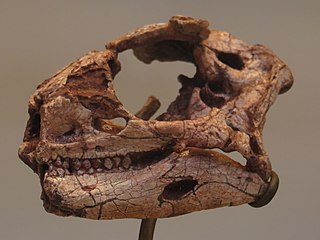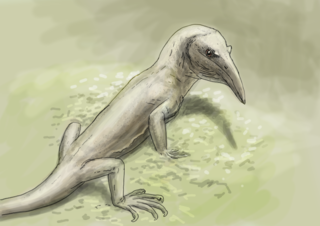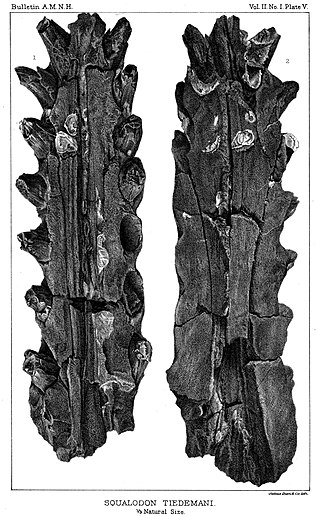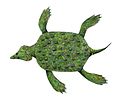
Filter feeders are aquatic animals that acquire nutrients by feeding on organic matters, food particles or smaller organisms suspended in water, typically by having the water pass over or through a specialized filtering organ that sieves out and/or traps solids. Filter feeders can play an important role in condensing biomass and removing excess nutrients from the local waterbody, and are therefore considered water-cleaning ecosystem engineers. They are also important in bioaccumulation and, as a result, as indicator organisms.

Lesothosaurus is a monospecific genus of ornithischian dinosaur that lived during the Early Jurassic in what is now South Africa and Lesotho. It was named by paleontologist Peter Galton in 1978, the name meaning "lizard from Lesotho". The genus has only one valid species, Lesothosaurus diagnosticus. Lesothosaurus is one of the most completely-known early ornithischians, based on numerous skull and postcranial fossils from the Upper Elliot Formation. It had a simpler tooth and jaw anatomy than later ornithischians, and may have been omnivorous in some parts of the year.

Placodus is an extinct genus of marine reptiles belonging to the order Placodontia, which swam in the shallow seas of the middle Triassic period. Fossils of Placodus have been found in Central Europe and China.

Nothosaurs were Triassic marine sauropterygian reptiles. They averaged about 3 metres (10 ft) in length, with a long body and tail. The feet were paddle-like, and are known to have been webbed in life, to help power the animal when swimming. The neck was quite long, and the head was elongated and flattened, and relatively small in relation to the body. The margins of the long jaws were equipped with numerous sharp outward-pointing teeth, indicating a diet of fish and squid.

Pterodaustro is a genus of ctenochasmatid pterodactyloid pterosaur from South America. Its fossil remains dated back to the Early Cretaceous period, about 105 million years ago.

Mesosaurus is an extinct genus of reptile from the Early Permian of southern Africa and South America. Along with it, the genera Brazilosaurus and Stereosternum, it is a member of the family Mesosauridae and the order Mesosauria. Mesosaurus was long thought to have been one of the first marine reptiles, although new data suggests that at least those of Uruguay inhabited a hypersaline water body, rather than a typical marine environment. In any case, it had many adaptations to a fully aquatic lifestyle. It is usually considered to have been anapsid, although Friedrich von Huene considered it to be a synapsid. Recent study of Mesosauridae phylogeny places the group as either the basal most clade within Parareptilia or the basal most clade within Sauropsida despite the skull of Mesosaurus possessing the "Synapsid condition" of one temporal fenestra.

Lariosaurus is an extinct genus of nothosaurid from the Middle Triassic of central and western Europe and China. With a complete specimen of L. xingyiensis measuring 70.5 cm (2.3 ft) long and L. hongguoensis possibly measuring up to 80 cm (2.6 ft) long, it was one of the smallest known nothosaurs. First discovered at Perledo on the Lake Como in 1830, it was named in 1847 by Curioni, its name meaning "Lizard from Larius", the ancient name of the lake. This makes it one of the earliest studied reptiles from the Alps. It is known from an almost complete skeleton holotype and several other fairly complete fossils.

Qianosuchus is an extinct genus of aquatic poposauroid archosaur from the middle Triassic (Anisian) Guanling Formation of Pan County, China. It is represented by two nearly complete skeletons and a crushed skull preserved in the limestone. Qianosuchus was at least 3 metres long, and had several skeletal adaptations which indicate a semi-marine lifestyle, similar to modern-day saltwater crocodiles. These adaptations have not been seen in any other archosaur from the Triassic.

Birgeria is a genus of carnivorous marine ray-finned fish from the Triassic period. Birgeria had a global distribution, with fossil known from Madagascar, Spitsbergen, Germany, Switzerland, Italy, Slovenia, China, Russia, Canada and Nevada, United States. The oldest fossils are from Griesbachian aged beds of the Wordie Creek Formation of East Greenland. Birgeria existed throughout the entire Triassic period, from the very beginning just after the Permian-Triassic mass extinction, up to the very end with its extinction during the Triassic-Jurassic mass extinction.

Besanosaurus is a extinct genus of Middle Triassic ichthyosaur from Monte San Giorgio of Italy and Switzerland, containing the single species B. leptorhynchus. Besanosaurus was named by Cristiano Dal Sasso and Giovanni Pinna in 1996, based on the nearly complete flattened skeleton BES SC 999, the holotype specimen. This skeleton is preserved across multiple thin rock slabs spanning 3.5 by 4 metres when assembled and took thousands of hours to prepare. Additional specimens from Monte San Giorgio that have previously been considered separate genera, including a partial skull named Mikadocephalus and a well-preserved, largely complete skeleton, have been reinterpreted as additional specimens of Besanosaurus. Putative specimens of Besanosaurus have been discovered in the Norwegian archipelago of Svalbard and Germany, although their attribution to this genus remains disputed.

Gephyrosaurus is an extinct genus of lepidosaurian reptile known from the Late Triassic to Early Jurassic of the United Kingdom. It is generally considered to be one of the most primitive members of the clade Rhynchocephalia.

Simosaurus is an extinct genus of marine reptile within the superorder Sauropterygia from the Middle Triassic of central Europe. Fossils have been found in deposits in France and Germany that are roughly 230 million years old. It is usually classified as a nothosaur, but has also been considered a pachypleurosaur or a more primitive form of sauropterygian.
Dianopachysaurus is an extinct genus of pachypleurosaur known from the lower Middle Triassic of Yunnan Province, southwestern China. It was found in the Middle Triassic Lagerstätte of the Guanling Formation. It was first named by Jun Liu, Olivier Rieppel, Da-Yong Jiang, Jonathan C. Aitchison, Ryosuke Motani, Qi-Yue Zhang, Chang-Yong Zhou and Yuan-Yuan Sun in 2011 and the type species is Dianopachysaurus dingi, thanking a Professor Ding for his help.

Teraterpeton is an extinct genus of trilophosaurid archosauromorphs. It is known from a partial skeleton from the Late Triassic Wolfville Formation of Nova Scotia, described in 2003. It has many unique features seen in no other related form, including an elongated, toothless snout and large openings for the nostrils. Because of this, Teraterpeton was originally placed in its own family, Teraterpetidae, related to Trilophosaurus. Newer studies generally place it within Trilophosauridae.

Diandongosuchus is an extinct genus of archosauriform reptile, possibly a member of the Phytosauria, known from the Middle Triassic of China. The type species Diandongosuchus fuyuanensis was named in 2012 from the Zhuganpo Formation of Yunnan Province. It is a marine species that shows similarities with another Chinese Triassic species called Qianosuchus mixtus, although it has fewer adaptations toward marine life. It was originally classified as the basal-most member of the pseudosuchian clade Poposauroidea. However, a subsequent study conducted by Stocker et al. indicated it to be the basalmost known phytosaur instead.
Qianxisaurus is an extinct genus of pachypleurosaur or alternatively a basal eosauropterygian known from the Middle Triassic of Guizhou Province, southwestern China. It contains a single species, Qianxisaurus chajiangensis.

Atopodentatus is an extinct genus of basal sauropterygian known from the early Middle Triassic (Anisian) of Guanling Formation in Luoping County, Yunnan Province, southwestern China. It contains a single species, Atopodentatus unicus. It is thought to have lived between 247 and 240 million years ago, during the Middle Triassic period, about six million years after the Permian extinction. Atopodentatus was an herbivorous marine reptile, although marine reptiles are usually omnivores or carnivores.

Cartorhynchus is an extinct genus of early ichthyosauriform marine reptile that lived during the Early Triassic epoch, about 248 million years ago. The genus contains a single species, Cartorhynchus lenticarpus, named in 2014 by Ryosuke Motani and colleagues from a single nearly-complete skeleton found near Chaohu, Anhui Province, China. Along with its close relative Sclerocormus, Cartorhynchus was part of a diversification of marine reptiles that occurred suddenly during the Spathian substage, soon after the devastating Permian-Triassic extinction event, but they were subsequently driven to extinction by volcanism and sea level changes by the Middle Triassic.

Silvestrosaurus is an extinct aquatic genus of lariosaurine nothosaurid sauropterygian known from the Middle Triassic of Monte San Giorgio, southern Switzerland. It contains a single species, Silvestrosaurus buzzii, originally considered to be a species of the closely related Lariosaurus. The species was named by Tschanz in 1989, based solely on the holotype PIMUZ T/2804 comprising the skull, the lower jaw, and a dis-articulated partial postcranial skeleton. Cyamodus hildegardis tooth bearing elements were found in the stomach region of the specimen. The holotype was collected at Punkt 902 of Monte San Giorgio, from layer 97 of the Grenzbitumen zone, dating to the Anisian-Ladinian boundary of the Middle Triassic. Kuhn-Schnyner (1990) reassigned the species to its own genus, creating the combination S. buzzii. The generic name honors a church near the collection locality of the holotype, dedicated to Saint Sylvester, a Pope during the reign of Constantine the Great, and from Greek saurus, meaning "lizard", a common suffix for genus names of extinct reptile.

Ankylorhiza is an extinct genus of toothed whale that lived in what is now the United States during the Oligocene epoch, between 29 and 23.5 million years ago. The type and only known species is A. tiedemani, though two fossil skeletons may represent an additional, second species within the genus. Ankylorhiza was about 4.8 meters (16 ft) long, with a long, robust skull bearing conical teeth that were angled forwards at the tip of the snout.
























